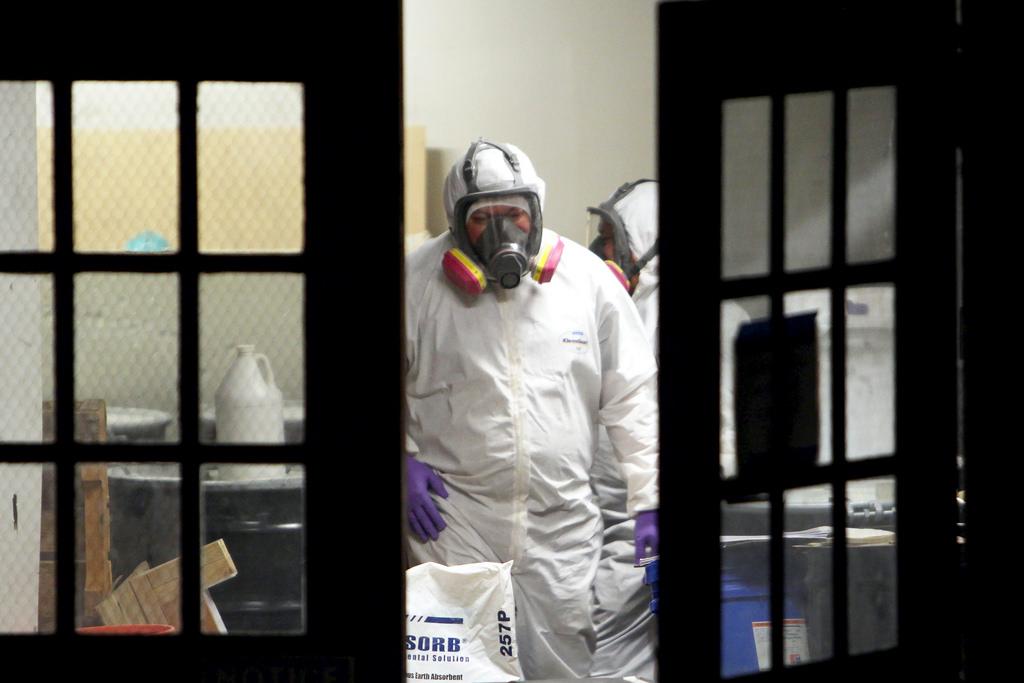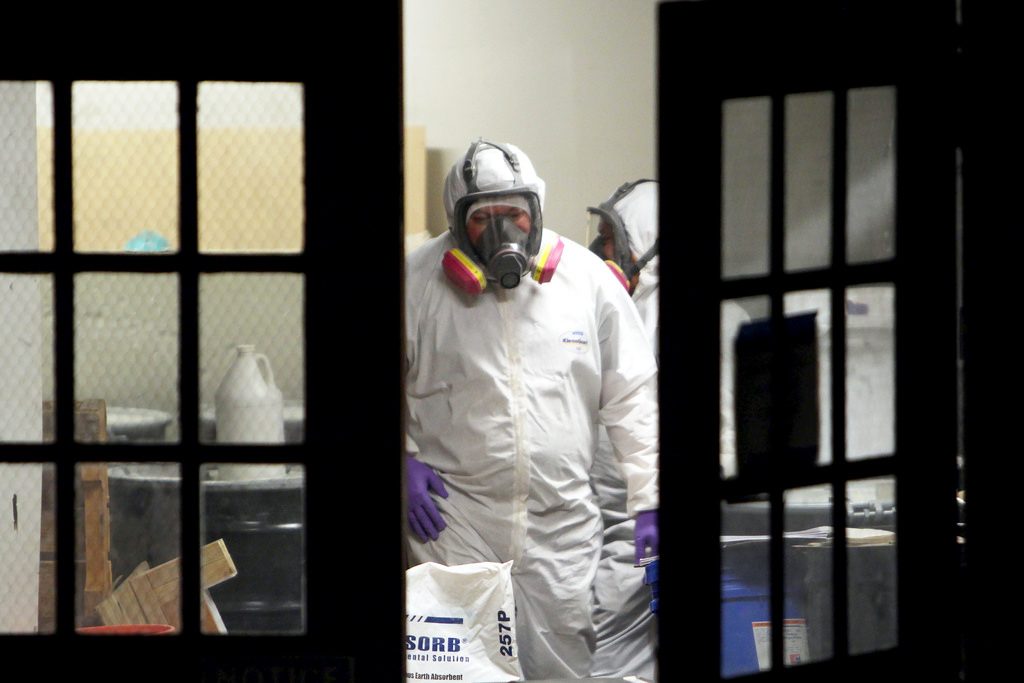 People in hazmat suits work in SF State’s Science Building, Thursday, Jan. 30, 2014. The building is closed after toxic chemicals were found inside. Photo by Gavin McIntyre / Xpress
People in hazmat suits work in SF State’s Science Building, Thursday, Jan. 30, 2014. The building is closed after toxic chemicals were found inside. Photo by Gavin McIntyre / Xpress
Mercury contamination in the Science Building has been linked to the third floor Treganza Anthropology Museum and the building’s basement, which contains archaeological artifacts.
The artifacts may have been “treated on-site with a variety of chemicals including mercury, arsenic and DDT,” according to the documents from Air & Water Sciences Environmental Consultants.
In 2000, a similar level of mercury was found surrounding Native American artifacts stored in the museum, according to anthropology lecturer Niccolo Caldararo, PhD.
He compared documents from Air & Water Sciences Environmental Consultants against data from a 2001 research paper. Both show the amount of contamination in the museum.
“I looked at (current) results and they essentially were the same that we discovered in 2000,” said Caldararo, who has worked in museums for 40 years. “None of the levels introduced any hazards. And anyway, you don’t just close down a building. I’ve been involved with 40 buildings that have contaminants and none of them were closed down.”
After reporting their results in 2000 to the Office of Environmental Health and Safety, officials called in a private consultant to measure the chemical levels and later, a separate company to mitigate any present hazards, according to Caldararo. The contaminants were allegedly cleaned up in 2001.
Caldararo recalled a CSU-wide environmental safety audit in 2007, which SF State failed.
Another health and safety audit was performed Aug. 28, 2013, in which SF State was “not sufficient” to standards in hazardous materials administration, laboratory standard and hazardous waste training.
Robert Shearer was the environmental health and occupational safety director of SF State from 1994 to 2009. In 2013, Shearer was charged with more than 100 felonies, including bribery. Any connection between Shearer’s role at the University to the current Science Building crisis is unconfirmed.
Caldararo, who was unaware of any mercury spills that may have occurred since the contamination of Native American artifacts, was surprised when someone knocked on his office door in January and told him he had to leave the building.
“What was found was minimal,” said Caldararo. “There were a couple locations that indicate some higher levels that might be dangerous, but you’d have to be right on top of them for there to be a hazard.”
The consultants investigating the building uncovered the strongest concentration of mercury vapors in the basement, followed only by traces of mercury in the third floor museum, according to the documents. They also found non-paint related lead in these locations.
“Some of these hazards are inherent in working with the archeological artifacts that are stored in the basement, Room 115 and the third floor museum rooms,” according to reports from Air & Water Sciences. “New procedures may be necessary regarding the (handling of) museum artifacts.”
Levels of mercury were found in several rooms used by the anthropology department. Fecal bacteria and E. coli were identified in small puddles of standing water on classroom floors and cracked lead-based paint was found on the walls of over 85 rooms, according to the documents.
“The decision to close the building was not taken lightly,” said University Spokeswoman Ellen Griffin. “The University has engaged objective, highly credentialed experts to analyze the situation and make recommendations based on careful review of hundreds of tests and data points.”
“If you clean a building like this, you really only want to do it once,” said Chip Prokop, the president of Air & Water Sciences.
Last week, President Leslie E. Wong announced that lead, asbestos, and mercury were undetected in the air throughout most of the building. Officials opened the doors of the Science Building to faculty and staff to mark priority items for removal.
“We’ve been following the requirements of Occupational Safety and Health Administration and we did the right thing,” said Caldararo. “It’s not anthropology that’s the problem here, it’s the building maintenance.”
“Asbestos is present in most of all buildings in San Francisco, so is lead paint,” said Caldararo. “There are all these procedures we are supposed to be following in terms of our laboratories and chemicals on campus and that would be something I would think we should be putting money toward—not retesting and testing a building that’s already been cleaned in the past and has levels that are so small, they seem miniscule.
An earlier version of this story implied that Robert Shearer worked at SF State in August 2013, which he did not. It also implied that information was compared from an audit in 2007, where it was actually a report from 2001; that Caldararo was a professor when he is a lecturer; that the same audit was performed in 2013 as the CSU-wide audit in 2007, when it was actually a separate type of environmental audit; and Chip Prokop’s name was incorrectly spelled as Propok. Additionally, there was an anthropology staff member who was quoted out of context. We regret the errors.








